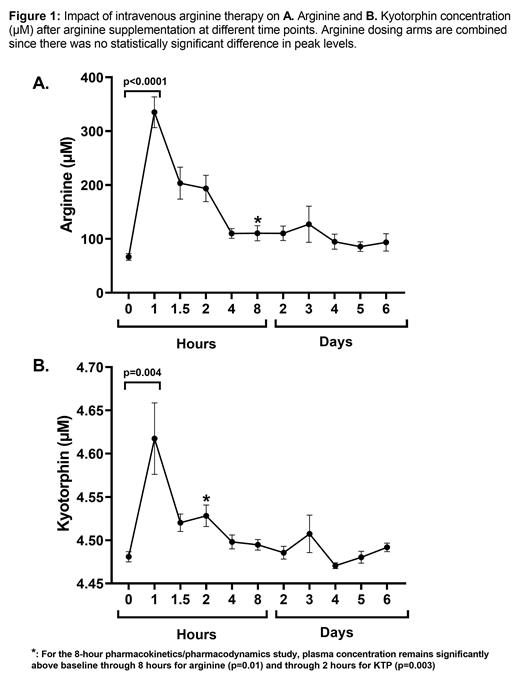Introduction: Low L-Arginine (Arg) bioavailability is associated with sickle cell disease (SCD) mortality and morbidity, including acute pain severity. Multiple phase 2 trials support the safety and efficacy of Arg therapy in children with SCD experiencing vaso-occlusive pain. Nitric oxide (NO) is a potent vasodilator depleted in SCD due to hemolysis. As the obligate substrate for NO production, Arg's mechanism-of-action is unknown but thought to be related in part to NO production. Kyotorphin (KTP) is an endogenous opioid analgesic composed of the amino acids tyrosine and Arg. Its nociceptive effects are through induction of Met-enkephalins release in the brain. Oral administration of Arg in wild-type mice increases the levels of KTP centrally. We have previously shown that Arg supplementation increases NO metabolites (NOx), improves mitochondrial function, decreases oxidative stress, and has opioid sparing effects in children with SCD. The association between IV Arg supplementation as a precursor to KTP in SCD is unknown and may represent a novel mechanism by which Arg decreases pain in patients with SCD.
Objective: To analyze the results of a pharmacokinetics/pharmacodynamics study, evaluating the association between Arg supplementation and plasma levels of KTP and other potential mechanisms-of-action related to Arg in children with SCD and vaso-occlusive pain episodes (VOE).
Methods: We conducted a pharmacokinetics/pharmacodynamics study of children aged 7-21 years with SCD hospitalized for VOE and randomized to treatment utilizing one of 3 dosing arms of Arg: 1) 100mg/kg IV three times/day, standard dose (n=4); 2) loading dose (200mg/kg) followed by standard dose (n=5); or 3) loading dose (200mg/kg) followed by continuous infusion (300mg/kg/day) until discharge (n=4). Plasma amino acids (arginine, ornithine, citrulline), global arginine bioavailability ratio (GABR; Arginine/[Citrulline+Ornithine]), KTP, NOx, exhaled NO, plasma arginase activity, and arginase-1 and -2 were measured. Mean±SD, paired t-tests, and Pearson correlation analyses between groups were performed where appropriate.
Results: A total of 13 patients (age 13±3 years, 56% male, 88% Hb-SS, 85% on hydroxyurea) were enrolled. Statistically significant increases in plasma arginine levels (Fig1A), plasma KTP levels (Fig1B), and GABR from pre-dose (0 hour) to 1, 1.5, and 2 hours after arginine infusion were observed, with a return to baseline 8 hours after Arg administration. Arg and KTP levels peaked between 60-90 minutes after arginine infusion in all study arms (p<0.001, p=0.004 respectively). There were no significant differences in peak concentration across all study arm doses. Rise in KTP levels strongly correlated with changes in plasma Arg concentration ( r=0.72, p<0.0001). Plasma NOx levels significantly increased from pre-dose to Tmax (Tmax= 1-2 hours; mean percent change 156±313%, p=0.02), as did exhaled NO (mean percent change 31±27%, p=0.02). Arginase activity also increased significantly after IV Arg infusion peaking at approximately 90 minutes (mean percent change 137±183%, p= 0.03) with return to baseline at 8 hours, while there was no significant change in arginase-1 or -2 concentrations over time.
Conclusion: IV Arg therapy increased plasma arginine concentration 2-5 times above baseline at presentation for VOE, and GABR also increased as expected in this pharmacokinetics study with both reaching a maximum concentration within 1 hour of infusion initiation in all dosing schemes. IV Arg supplementation increases plasma NOx levels suggesting a role for vasodilation as a potential mechanism-of-action during SCD-VOE. Exhaled NO also increased significantly, consistent with previous reports. Interestingly, IV Arg supplementation acutely increased arginase activity without a significant change in arginase concentration. Most notably, we report for the first time the impact of IV Arg therapy on plasma levels of KTP in SCD. As KTP is an endogenous opioid analgesic, this may represent a novel mechanism-of-action of Arg therapy that warrants further investigation. This observation may also have implications for the potential use of arginine supplementation in pain syndromes beyond sickle cell disease.
OffLabel Disclosure:
Morris:Trility: Consultancy, Membership on an entity's Board of Directors or advisory committees; Food as Medicine Therapeutics: Current Employment, Current equity holder in private company, Other: Executive Director of new Start-up company; Roche: Consultancy, Other: ad hoc consultant; CSL Behring: Consultancy, Other: ad hoc consultant; UCSF-Benioff Children's Hospital Oakland: Consultancy, Patents & Royalties: Inventor of licensed patents generating royalties.
L-Arginine in sickle cell disease


This feature is available to Subscribers Only
Sign In or Create an Account Close Modal